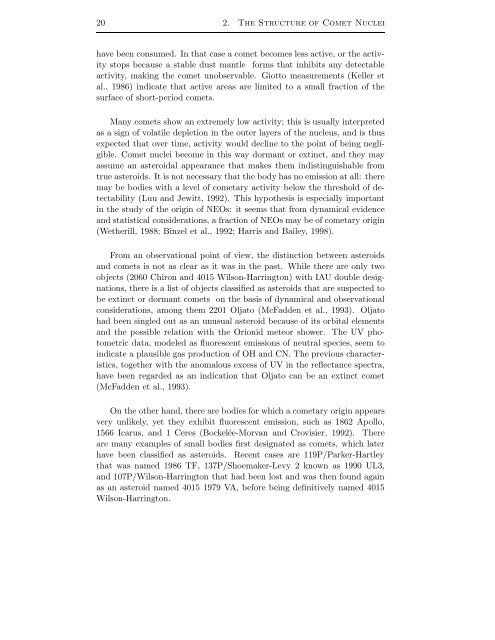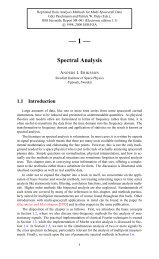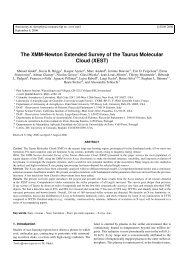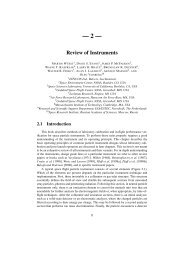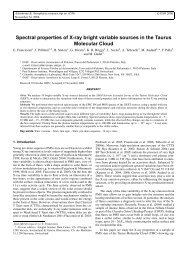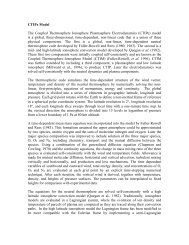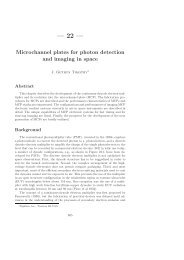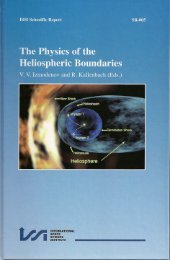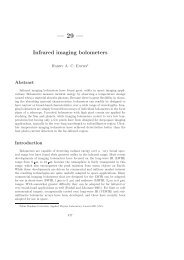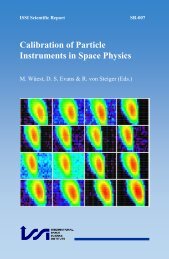Heat and Gas Diffusion in Comet Nuclei (pdf file 5.5 MB) - ISSI
Heat and Gas Diffusion in Comet Nuclei (pdf file 5.5 MB) - ISSI
Heat and Gas Diffusion in Comet Nuclei (pdf file 5.5 MB) - ISSI
You also want an ePaper? Increase the reach of your titles
YUMPU automatically turns print PDFs into web optimized ePapers that Google loves.
20 2. The Structure of <strong>Comet</strong> <strong>Nuclei</strong><br />
have been consumed. In that case a comet becomes less active, or the activity<br />
stops because a stable dust mantle forms that <strong>in</strong>hibits any detectable<br />
activity, mak<strong>in</strong>g the comet unobservable. Giotto measurements (Keller et<br />
al., 1986) <strong>in</strong>dicate that active areas are limited to a small fraction of the<br />
surface of short-period comets.<br />
Many comets show an extremely low activity; this is usually <strong>in</strong>terpreted<br />
as a sign of volatile depletion <strong>in</strong> the outer layers of the nucleus, <strong>and</strong> is thus<br />
expected that over time, activity would decl<strong>in</strong>e to the po<strong>in</strong>t of be<strong>in</strong>g negligible.<br />
<strong>Comet</strong> nuclei become <strong>in</strong> this way dormant or ext<strong>in</strong>ct, <strong>and</strong> they may<br />
assume an asteroidal appearance that makes them <strong>in</strong>dist<strong>in</strong>guishable from<br />
true asteroids. It is not necessary that the body has no emission at all: there<br />
may be bodies with a level of cometary activity below the threshold of detectability<br />
(Luu <strong>and</strong> Jewitt, 1992). This hypothesis is especially important<br />
<strong>in</strong> the study of the orig<strong>in</strong> of NEOs: it seems that from dynamical evidence<br />
<strong>and</strong> statistical considerations, a fraction of NEOs may be of cometary orig<strong>in</strong><br />
(Wetherill, 1988; B<strong>in</strong>zel et al., 1992; Harris <strong>and</strong> Bailey, 1998).<br />
From an observational po<strong>in</strong>t of view, the dist<strong>in</strong>ction between asteroids<br />
<strong>and</strong> comets is not as clear as it was <strong>in</strong> the past. While there are only two<br />
objects (2060 Chiron <strong>and</strong> 4015 Wilson-Harr<strong>in</strong>gton) with IAU double designations,<br />
there is a list of objects classified as asteroids that are suspected to<br />
be ext<strong>in</strong>ct or dormant comets on the basis of dynamical <strong>and</strong> observational<br />
considerations, among them 2201 Oljato (McFadden et al., 1993). Oljato<br />
had been s<strong>in</strong>gled out as an unusual asteroid because of its orbital elements<br />
<strong>and</strong> the possible relation with the Orionid meteor shower. The UV photometric<br />
data, modeled as fluorescent emissions of neutral species, seem to<br />
<strong>in</strong>dicate a plausible gas production of OH <strong>and</strong> CN. The previous characteristics,<br />
together with the anomalous excess of UV <strong>in</strong> the reflectance spectra,<br />
have been regarded as an <strong>in</strong>dication that Oljato can be an ext<strong>in</strong>ct comet<br />
(McFadden et al., 1993).<br />
On the other h<strong>and</strong>, there are bodies for which a cometary orig<strong>in</strong> appears<br />
very unlikely, yet they exhibit fluorescent emission, such as 1862 Apollo,<br />
1566 Icarus, <strong>and</strong> 1 Ceres (Bockelée-Morvan <strong>and</strong> Crovisier, 1992). There<br />
are many examples of small bodies first designated as comets, which later<br />
have been classified as asteroids. Recent cases are 119P/Parker-Hartley<br />
that was named 1986 TF, 137P/Shoemaker-Levy 2 known as 1990 UL3,<br />
<strong>and</strong> 107P/Wilson-Harr<strong>in</strong>gton that had been lost <strong>and</strong> was then found aga<strong>in</strong><br />
as an asteroid named 4015 1979 VA, before be<strong>in</strong>g def<strong>in</strong>itively named 4015<br />
Wilson-Harr<strong>in</strong>gton.


